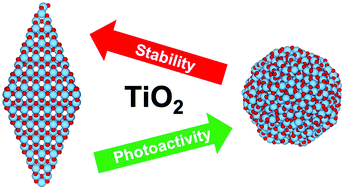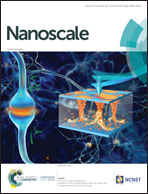Understanding the interplay between size, morphology and energy gap in photoactive TiO2 nanoparticles†
Abstract
Anatase TiO2 nanoparticles (NPs) have the potential to photocatalyse water splitting using UV light, to thus provide hydrogen fuel in a clean and sustainable manner. Such NPs have optical gaps covering a small range of relatively high energy solar photons, giving rise to low photo-efficiencies. Although anatase NPs with 10–20 nm diameters thermodynamically prefer crystalline faceted morphologies, application of physico-chemical procedures can produce more rounded NPs with amorphous shells. Such engineered metastable core–shell NPs (so-called black TiO2 NPs) have reduced band gaps due to shell-induced band edge broadening, resulting in higher photoactivities. For <5 nm diameters, TiO2 NPs typically exhibit spherical-like NP morphologies, which also display enhanced photoactivity. For smaller NPs it is difficult to experimentally determine their thermodynamic stability and internal atomic structure, to help rationalise their higher photoactivities. Employing accurate electronic structure calculations, we establish the relative stability of spherical and faceted stoichiometric TiO2 NPs with 1–3.4 nm diameters. Mirroring experimental preparation, simulated thermal annealing is found to significantly stabilise relaxed spherical cut anatase NPs. We find that the smallest spherical NPs become amorphized by annealing, but, for diameters >2 nm, annealing yields NPs with anatase-cores and amorphous-shells. Like larger black TiO2 core–shell NPs, we confirm that our core–shell NPs are metastable relative to faceted anatase NPs and have significantly smaller optical gaps than faceted NPs. Our calculated gaps are in excellent agreement with experimental data, strongly supporting the validity of our NP models. Energy gap narrowing in these core–shell NPs is found to be due to broadening of valence band states induced by the amorphous shell, analogous to the mechanism proposed for black TiO2 NPs. Our stoichiometric NPs also show that this band narrowing effect does not require the disordered shells to be non-stoichiometric or for incorporation of other atom types. Instead, we find that this effect mainly arises from 4-coordinated Ti atoms in the amorphous shell. Our careful and systematic computational investigation, using NP models of unprecedented realism, thus provides direct confirmation that the enhanced photoactivity in small spherical TiO2 NP observed in experiment is due to the formation of metastable core–shell NPs with 4-coordinated Ti centres.

- This article is part of the themed collection: Editor’s Choice: Computational studies of nanomaterials for energy, catalysis and electronics


 Please wait while we load your content...
Please wait while we load your content...